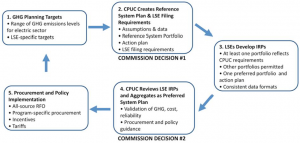Achieving a 40% reduction in greenhouse gas emissions by 2030 drives this California initiative
Creating an Integrated Resource Plan is a formidable challenge. I know; I’ve helped create and write several IRPs during the past decade that each followed a process developed 25 years ago. This is why the process currently being proposed by the California Public Utilities Commission (CPUC) staggers me.
Typically, IRPs created by a utility or a load serving entity (LSE) focus on providing reliable, affordable power for their service area and customers. While these IRPs comprise a wide range of generation, costs, transmission and distribution, and service, they are isolated plans.

The CPUC proposes to elevate all that. Its proposal involves an iterative process to compile individual IRPs into one statewide resource plan—in other words, a resource plan using the state as its service area. This process seeks to balance the individual loads, generation resources, planning perspectives, power grids, and other aspects of each LSE—large and small, public and private—into one cohesive direction that focuses energy generation in the state.
Senate Bill 350, which initiated the CPUC proposal, requires an IRP development process that meets California’s greenhouse gas (GHG) emission reduction targets. The upshot, however, requires a modernized grid to transmit increasing amounts of renewable energy. Among many other goals, SB 350 calls for 50% renewable generation by 2030, essentially doubling current output. The pending SB 100 ups the ante by requiring 60% renewable generation by 2030 and a non-mandatory 100% by 2045.
This proposed energy resource planning initiative requires coordination among the CPUC and multiple state agencies: California Energy Commission (CEC), California Air Resources Board (CARB), and California Independent System Operators (CAISO). The proposal, which has garnered the input from LSEs and other stakeholders, still requires approval by the five state Commissioners.
The initiative is nothing if not daunting. It assimilates each LSE’s IRP process into a hierarchical five-step iterative process (shown here, taken from the CPUC proposal document).
Five iterative steps essentially involve two IRP cycles. For the process to be effective, all LSEs must develop their individual IRPs from similar positions. Starting with SB 350’s GHG goals (1), the CPUC defines foundational inputs and assumptions, a Reference System Portfolio (generation resources that meet policy goals), and filing requirements for each LSE (2).
LSEs create individual IRPs with one or more portfolios, at least one of which must be created from Reference System Portfolio elements. The IRPs must maintain reliability, minimize costs (and thus bills), and comply with GHG goals, with priority given to disadvantaged communities. The filed IRPs conclude with one preferred portfolio, a short-term action plan, and any procurement requests (3).
After all IRPs are filed, the CPUC first reviews them individually to ensure compliance with policy goals and the process, then as an aggregate to create one statewide portfolio that meets policy and reliability goals. If all goes well, the CPUC approves and certifies the individual IRPs, then creates a preferred system-wide portfolio (replacing the Reference System Portfolio) and a set of short-term actions for implementing the preferred portfolio (4). Finally, the CPUC takes the steps necessary to procure new resources, fund programs, change tariffs, and initiate anything else needed to implement the preferred portfolio (5). This two-year process then begins anew.
A 20,000 foot perspective of the process and its communication. Let’s try to get our arms around this. The proposed process involves several state agencies and numerous LSEs: a half dozen investor-owned utilities (IOUs), dozens of publicly-owned utilities (POUs), about two dozen electric service providers, and a handful of rural electric cooperatives and community choice aggregators. The largest LSEs will file a “Standard LSE Plan” (these plans are to be assimilated in step 4 and represent about 75% of statewide load); sixteen POUs will file an IRP as outlined by the CEC; and the remaining will file an “Alternative LSE Plan”.
If approved, this process will be carried out for the first time over the next two years—in a state whose economy is larger than all but five countries.
How well these numerous IRPs are created and written will have a profound effect on the effectiveness and efficiency of steps 4 and 5. In addition, the clarity of the IRPs and of the overall process in general, both in its written and spoken communication, will directly affect how the myriad stakeholders, media, and customers perceive the process.
Renewable generation is visible. As renewables increase on the power grid, so too will public participation and the need for clear communication—a critical aspect of the initiative’s success.
—Rich Maggiani